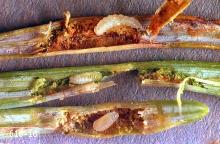Contarinia spp.
Pest description and crop damage The adult Douglas-fir needle midge is a small fly. Three different midges infest Douglas-fir: one species feeds near the needle base, one feeds near the tip of the needle, and the third feeds near the middle. The tiny white larvae of the Douglas-fir needle midge mine the inside of needles, which become yellowed and distorted. Infested needles often have a sharp bend at the injury site. Damaged needles often drop from the tree, and heavy midge infestations can cause severe defoliation.
Biology and life history The midges pupate in the ground, with the adults emerging around budbreak in the spring. They lay eggs on the new growth, and the newly hatched larvae mine the needles and feed through the summer. At the end of the summer, they drop to the ground to pupate. There is one generation per year.
Sampling and thresholds Time applications, based on adult needle midge trap catch, to coincide with adult emergence.
Management-cultural control
Prune out heavily infested twigs and branches.
Management-chemical control
See:
Chemical Control of Nursery Pests
For more information
Johnson, W.T. and H.H. Lyon (1991), Insects That Feed on Trees and Shrubs, 2nd ed., Cornell University Press (p. 44).
Ornamentals Northwest Archives: Douglas-fir needle midge (http://oregonstate.edu/dept/nurserystartup/onnpdf/onn060108.pdf)



